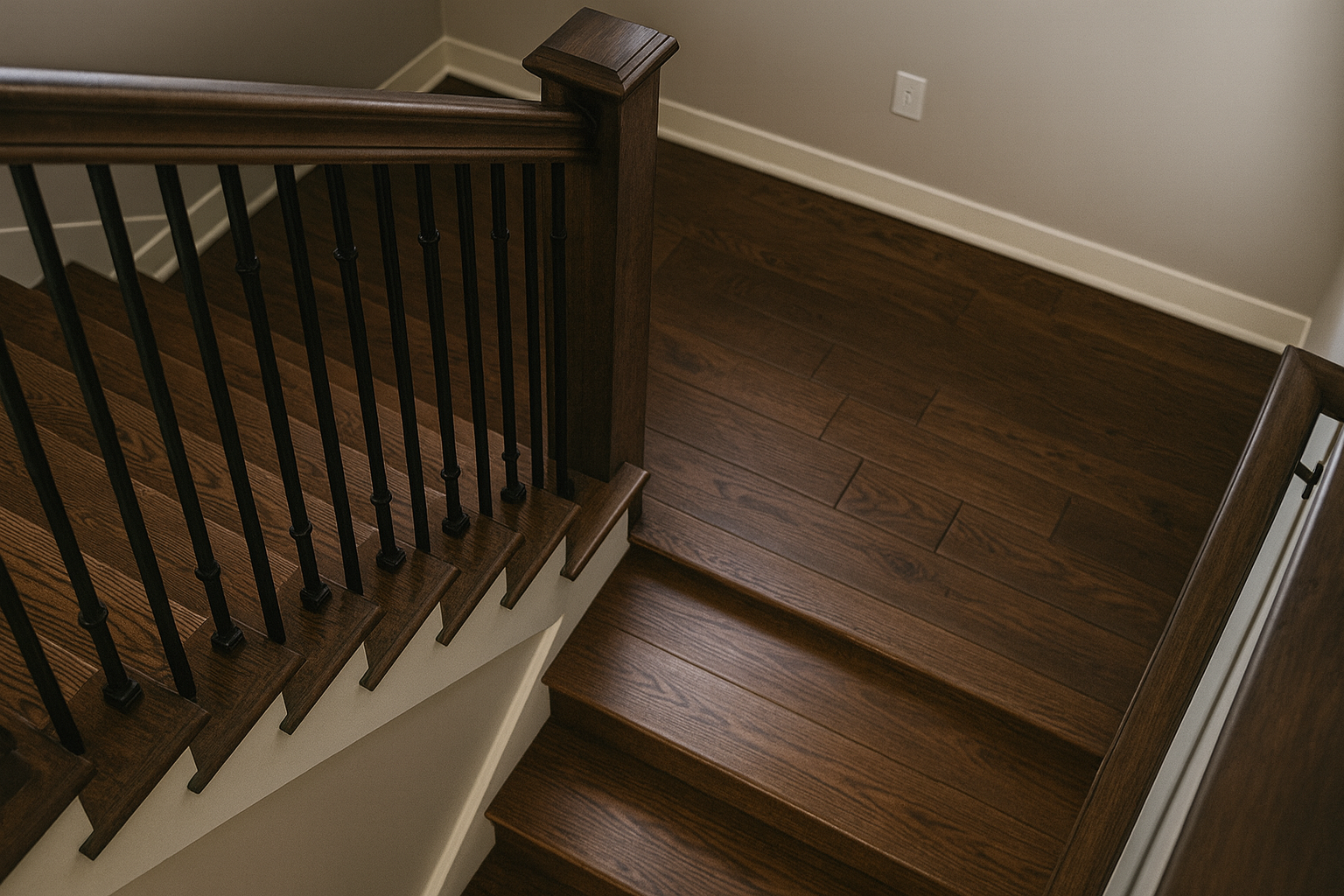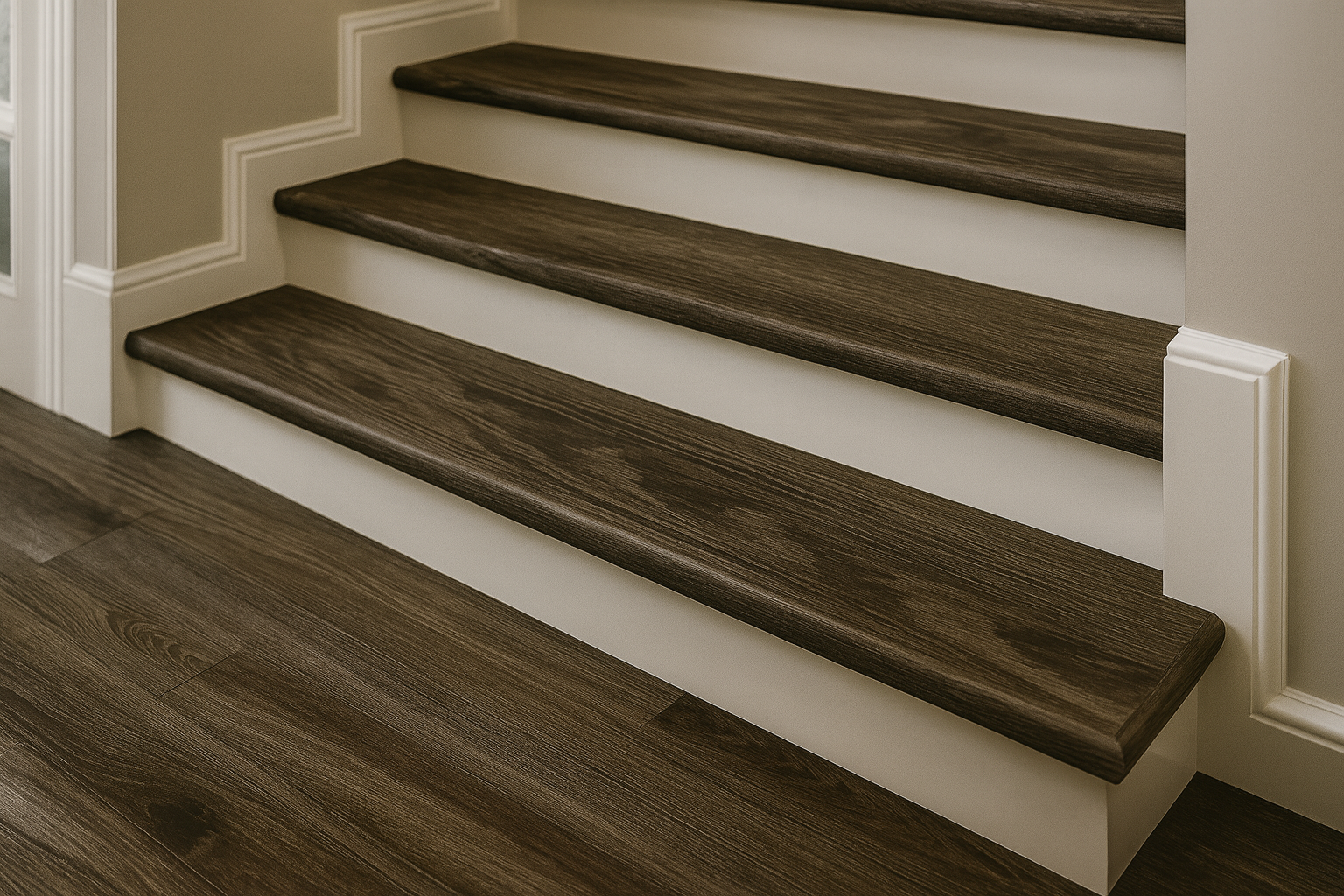Picking flooring for stairs feels tougher than it should. You want something that looks good, but it also has to handle traffic, stay safe, and fit your budget.
With so many choices – hardwood, vinyl, carpet, laminate – it’s hard to know what’s worth it.
We’ll break down the best flooring for stairs, comparing the pros and cons so you can narrow in on what works for your home.
Our Top 3 Picks
1. Solid Hardwood Flooring
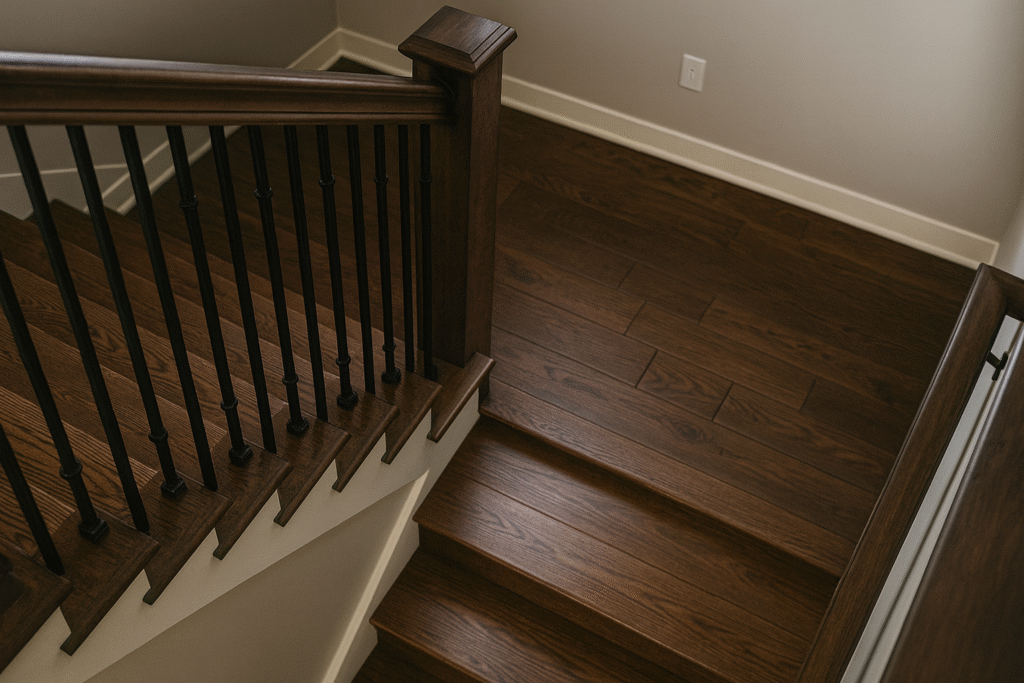
Solid hardwood is a timeless option for stairs and landings. Each plank is crafted from a single piece of natural wood – often oak, walnut, or maple – giving it authentic grain, warmth, and character.
Its durability makes it ideal for high-traffic areas like staircases, while its natural beauty elevates the overall design of your home.
Hardwood can be refinished multiple times, which means your stairs can keep looking fresh for decades.
Features
- Made from single wood pieces with authentic grain patterns
- Can be sanded and refinished multiple times
- Typically thick enough to withstand heavy impact
- Often paired with stair nosings for safety and durability
- Installed with nails or adhesives depending on stair structure
Pros
- Long lifespan; refinishing extends usability
- Warm, elegant look that adds home value
- Withstands heavy foot traffic and impacts
- Easier to clean than carpet – no trapped dust or allergens
- Hypoallergenic, good for air quality
Cons
- Higher upfront cost than laminate or carpet
- Prone to scratches and dents in busy or pet-friendly homes
- Can be slippery without grip treatments or stair runners
- Installation is complex and best left to professionals
- Expands and contracts with humidity, requiring maintenance
2. Engineered Wood Flooring
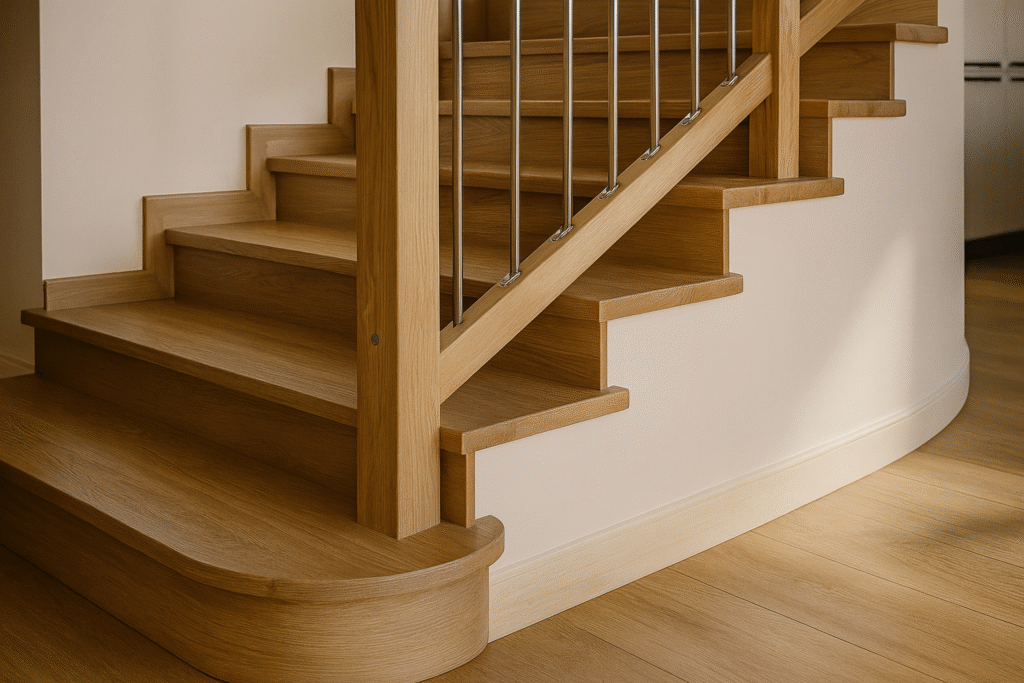
Engineered wood combines the authentic beauty of real hardwood with the added stability of a layered core.
It’s built with a top layer of natural wood bonded to multiple layers of plywood or high-density fiberboard, which makes it less prone to warping from moisture or temperature changes.
For stairs and landings, this means you get the elegance of hardwood with performance that’s better suited to high-traffic, climate-shifting areas.
Features
- Multi-layer construction with a real hardwood veneer on top
- Typically 12mm+ thick for stair durability
- Can be sanded and refinished multiple times
- Installation options: click-lock, glue-down, or nail-down
- Wide range of species and finishes (oak, ash, walnut, lacquered, or oiled)
- Compatible with underfloor heating (with proper precautions)
Pros
- Greater stability than solid hardwood, resisting warping and gaps
- Long-lasting and can be refinished like real wood
- Easier to maintain than carpet – wipes clean and carries fewer allergens
- Wide variety of looks to match home style and value
- Works better than solid wood with underfloor heating systems
Cons
- Higher upfront cost than vinyl or laminate
- Installation on stairs is complex and best for professionals
- Less flexible for custom shaping than solid hardwood
- Can be slippery without anti-slip finishes or stair runners
3. Laminate Flooring
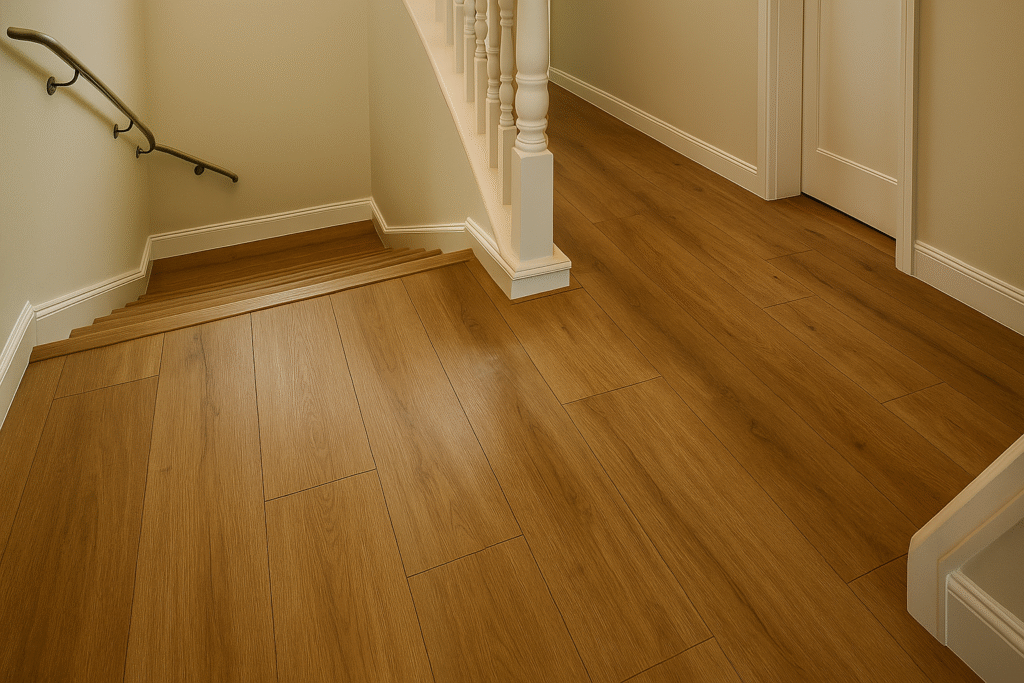
Laminate is a practical, budget-friendly option for stairs and landings. Made with a fiberboard core topped by a photographic wood-look layer sealed under a tough resin, it mimics hardwood at a fraction of the cost.
Its wear-resistant surface makes it ideal for high-traffic staircases, and it’s easier to install and maintain than many other options.
For homeowners wanting a modern look without the price tag of real wood, laminate is a strong contender.
Features
- High-density fiberboard core with a resin-coated wood-look layer
- Requires stair nosing for a safe, finished edge
- Installed with glue or nails for secure attachment (no underlay)
- Precision cuts needed to fit stair dimensions
- Available in a wide range of finishes and styles
Pros
- Tough, scratch- and wear-resistant surface
- Much more affordable than hardwood
- Simple maintenance – sweep and mop
- DIY installation is possible with the right tools
- Wide design choices to suit any décor
- Creates a sleek, coordinated look with flooring on landings
Cons
- Can be slippery – may need anti-slip strips or finishes
- Vulnerable to water damage if joints aren’t sealed well
- Harder to repair damaged sections compared to hardwood
- Less warmth and sound absorption than carpet
- Lacks the “authentic” feel of real wood underfoot
4. Luxury Vinyl Tile (LVT)
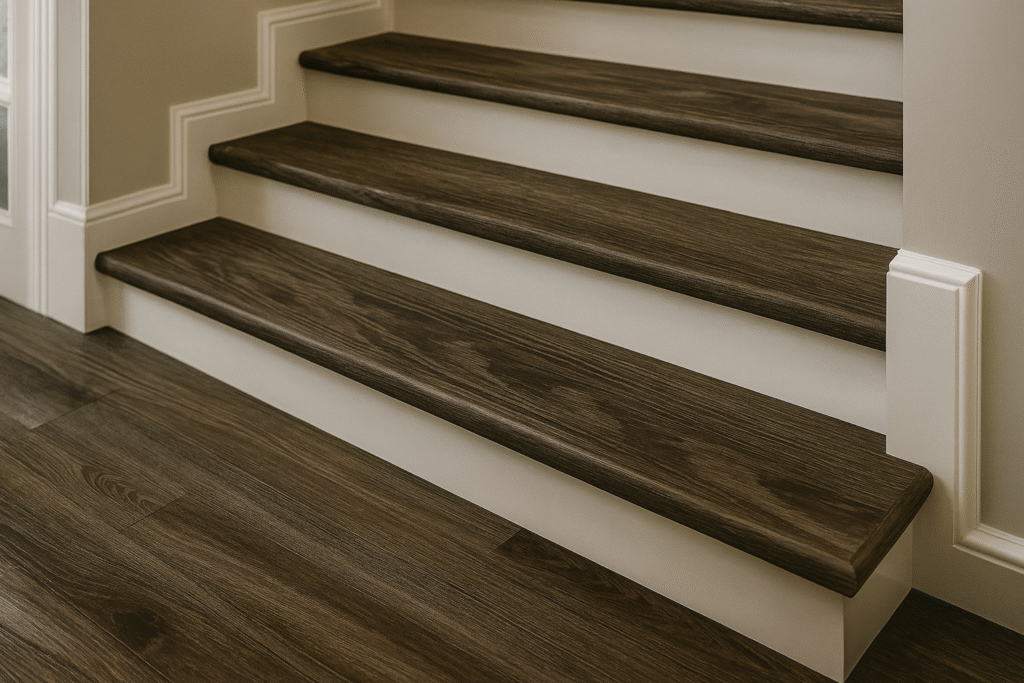
LVT has become one of the go-to choices for stairs and landings thanks to its mix of practicality and style.
Built with multiple layers – including a photographic design layer and a tough wear surface – it convincingly mimics wood, stone, or patterned tile while standing up to everyday wear.
It’s waterproof, scratch-resistant, and warmer underfoot than natural stone or hardwood, making it both functional and comfortable for busy staircases.
Features
- Multi-layer construction with realistic wood or stone visuals
- Protective wear layer resists scratches, stains, and scuffs
- Fully waterproof for moisture-prone areas
- Compatible with underfloor heating
- Can be installed with click-lock systems or adhesive
- Available in a wide range of wood, tile, and patterned styles
Pros
- Excellent durability for high-traffic areas
- Moisture- and stain-resistant surface
- Easy to maintain – simple sweeping and mopping
- Softer, quieter feel underfoot than tile or wood
- Versatile designs for any décor style
- Can sometimes be installed over existing flooring
Cons
- Thinner profile than laminate or hardwood may feel less “solid”
- Lower-quality LVT can wear down faster on stairs
- Needs a perfectly even subfloor to avoid unevenness
- Floating installations may require expansion gaps
- High-end LVT can approach the cost of engineered wood
5. Carpet Flooring
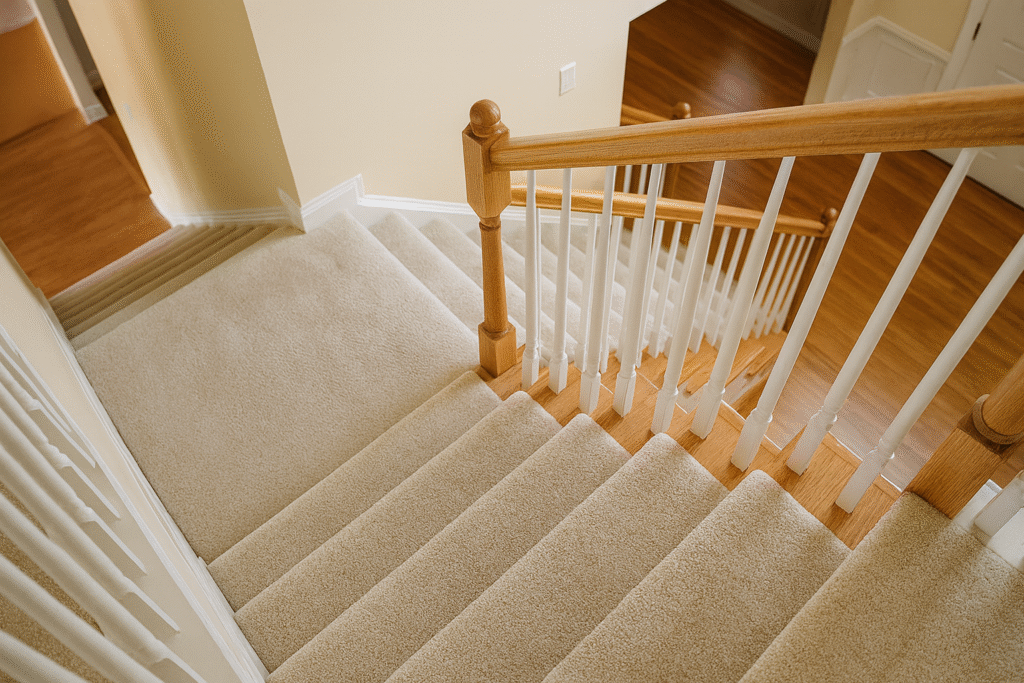
Carpet is one of the most comfortable and family-friendly options for stairs and landings. It adds warmth, reduces noise, and provides extra grip underfoot – important for households with kids, pets, or elderly family members.
Available in a wide range of materials, colors, and patterns, carpet gives you flexibility to blend safety with style.
Whether installed wall-to-wall or as a runner, it can transform stairs into both a functional and design-focused feature.
Features
- Materials include wool, nylon, polypropylene, and other synthetic blends
- Installed fully or as runners with optional stair rods
- Cushioned by underlay for comfort and durability
- Wide variety of piles and patterns (cut, loop, twist, striped, geometric)
- Reduces impact noise in stairwells and hallways
Pros
- Provides traction, reducing slip risk
- Soft underfoot and comfortable to walk on
- Absorbs sound better than hard flooring
- Large variety of colors, textures, and styles
- Stain-resistant options available for busy households
- Creates a unified look with landings and hallways
Cons
- Requires frequent cleaning to control dust and dirt
- Light colors show stains more easily
- Plush or deep pile carpets may wear quickly on stairs
- Installation is more complex and best left to professionals
- Can trap allergens, less ideal for those with sensitivities
Comparison: Best Flooring for Stairs & Landings
| Decision Criteria | Solid Hardwood | Engineered Wood | Laminate | LVT (Luxury Vinyl Tile) | Carpet |
|---|---|---|---|---|---|
| Withstands heavy stair traffic | ✔️ | ✔️ | ✔️ | ✔️ | ✔️ |
| Waterproof | ❌ | ❌ | ❌ | ✔️ | ❌ |
| High traction underfoot | ❌ | ❌ | ❌ | ✔️ | ✔️ |
| Noise reduction | ❌ | ❌ | ❌ | ✔️ | ✔️ |
| Easy day-to-day maintenance | ✔️ | ✔️ | ✔️ | ✔️ | ❌ |
| Allergen friendly | ✔️ | ✔️ | ✔️ | ✔️ | ❌ |
| Can be refinished | ✔️ | ✔️ | ❌ | ❌ | ❌ |
| Works with underfloor heating | ❌ | ✔️ | ❌ | ✔️ | ❌ |
| DIY friendly on stairs | ❌ | ❌ | ✔️ | ✔️ | ❌ |
| Quick to install on stairs | ❌ | ❌ | ✔️ | ✔️ | ❌ |
| Long lifespan | ✔️ | ✔️ | ✔️ | ✔️ | ✔️ |
| Wide style variety | ✔️ | ✔️ | ✔️ | ✔️ | ✔️ |
| Warm underfoot | ❌ | ❌ | ❌ | ✔️ | ✔️ |
| Budget-friendly upfront | ❌ | ❌ | ✔️ | ✔️ | ✔️ |
How to Choose the Best Flooring for Stairs & Landings
1. Durability
Stairs see some of the heaviest traffic in any home, so durability is non-negotiable.
Hardwood and engineered wood both excel here, especially in harder species like oak. LVT also performs well with its scratch-resistant wear layer.
Laminate offers solid durability for the price, while carpet can wear faster unless you choose a dense, contract-rated pile.
Best: Hardwood, Engineered Wood, LVT
Less good: Carpet (unless high-quality, low pile)
2. Safety & Slip Resistance
Safety is a top concern on stairs. Carpet is the clear leader – it cushions steps and reduces slip risk. LVT with textured finishes can also offer grip.
Hardwood, engineered wood, and laminate look great but can be slippery without stair runners, nosings, or anti-slip finishes.
Best: Carpet, Textured LVT
Less good: Smooth hardwood, engineered wood, laminate
3. Aesthetic Appeal
Stairs are a focal point, so style matters. Hardwood delivers a timeless, upscale look that adds to resale value. Engineered wood offers similar beauty with modern finish options.
LVT and laminate mimic wood and stone convincingly, giving you plenty of choice at a lower cost. Carpet provides warmth and color variety but may not deliver the same high-end feel.
Best: Hardwood, Engineered Wood
Less good: Carpet for premium resale impact
4. Maintenance
Busy households benefit from flooring that’s easy to care for. LVT leads here – it’s waterproof, stain-resistant, and only needs simple cleaning. Laminate also scores well but is less forgiving with water.
Hardwood and engineered wood require refinishing to stay looking their best. Carpet is the highest-maintenance option, as it traps dirt and allergens.
Best: LVT, Laminate
Less good: Carpet, Hardwood (due to refinishing needs)
5. Budget
Flooring costs range widely. Laminate and LVT are the most affordable options while still offering solid durability and style.
Carpet can be budget-friendly but varies depending on material and underlay.
Engineered wood is mid-range, balancing cost with stability. Solid hardwood sits at the premium end, offering long-term value but with a higher upfront price.
Best: Laminate, LVT, Budget Carpet
Less good: Solid Hardwood
6. Installation Complexity
Staircases require precision. Hardwood and engineered wood need professional installation due to stair nosings and tricky cuts.
LVT and laminate are easier to fit, with some DIY potential. Carpet installation should also be done by pros for safety and durability.
Best: LVT, Laminate
Less good: Hardwood, Engineered Wood
7. Comfort & Sound Absorption
For comfort and noise reduction, carpet is the standout choice – it softens footsteps and dampens sound. LVT offers some noise absorption and warmth, while hardwood, engineered wood, and laminate tend to feel harder and louder without rugs or runners.
Best: Carpet
Less good: Hardwood, Laminate
Bottom Line
👉 The right choice depends on balancing what matters most:
- hardwood and engineered wood for timeless beauty and value
- LVT for practicality and durability
- laminate for affordability
- carpet for safety and comfort
Frequently Asked Questions
Is it better to carpet or wood stairs for resale value?
Wood stairs – whether solid or engineered – tend to boost resale value more than carpet because of their timeless appeal. However, carpet can still appeal to buyers who prioritize comfort and safety.
Can you mix flooring types on stairs and landings?
Yes, but it should be done carefully. Many homeowners use a wood or vinyl landing with a carpet runner on the stairs to balance style with safety. Consistency in color and tone keeps the look cohesive.
Do stairs need special nosing when installing hard flooring?
Absolutely. Stair nosing provides a smooth edge, reduces wear, and improves safety by reducing slip risk. Skipping it can make hard flooring less durable and unsafe on stairs.
How often should stair flooring be replaced?
It depends on the material and traffic levels. Carpet may need replacing every 7–10 years, while hardwood and engineered wood can last decades with refinishing. LVT and laminate often last 15–20
years with proper care.
Conclusion
When it comes to the best flooring for stairs, there’s no one right answer.
Hardwood gives you timeless style and lasting value, engineered wood adds stability with the same authentic look, and laminate or LVT bring practical, budget-friendly durability. Carpet, on the other hand, offers comfort, grip, and quiet steps that hard surfaces can’t match.
The right choice really depends on what matters most in your home – safety, maintenance, or appearance. Book a free in-home appointment and we’ll bring samples, check your space, and help you compare options side by side.


